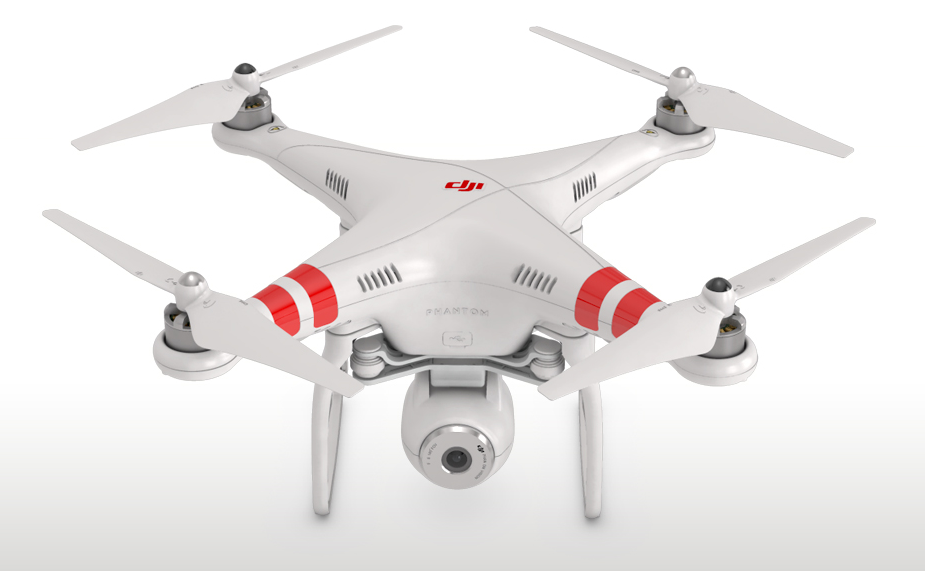Remote-controlled aircraft hobbyists have been trying to MacGyver small digital cameras to their airborne contraptions for years. Chinese manufacturer DJI has finally come along and rendered all that tinkering unnecessary, selling what’s essentially a flying camera ready-to-go out of the box: The DJI Phantom 2 Vision.
Setup
There’s an acronym in remote-controlled flying: “RTF,” or “Ready-to-Fly.” Many times, products advertise themselves as “RTF” when that’s really only half-true—but that’s not the case here. All you’ve got to do to get airborne with the Phantom 2 Vision is charge up the flight battery and Wi-Fi range extender, screw on its four propellers and pop four AA-size batteries into the controller. After you download and set up the mobile app and attach the range extender and phone clip to the controller, you’re clear for liftoff.
Flying
I’ve never met a remote-controlled aircraft quite this easy to fly. At two-and-a-half pounds, it has a heft that’s helpful for stability (though I wouldn’t risk it on a particularly windy day). The quadcopter’s four engines and propellers allow it to maneuver like a helicopter, making it pretty nimble once you get the hang of it—it flies on three axes and can hover with minimal pilot input thanks to its internal GPS system.
The Phantom’s control scheme was a little counter-intuitive at first—it would be nice if it was customizable, as is the case with more complex (and often very expensive) RC airplane transmitters. But with a little practice, flying the Phantom gets simple quick. Bringing it back to terra firma manually, however, can be a bit tricky—I damaged a propeller on what might be called a “hard landing.” But there’s a GPS-based auto-land feature that’s useful for the uninitiated, and attaching a new prop was less than a five-minute job with a tool DJI provides for the task. And there’s a saying in aviation: Any landing where you can use the plane again is a great landing.
I should probably note that somebody with less R/C flying experience might find the learning curve a bit more steep. Helpful tip: Try to keep the back of the aircraft facing you until you start learning how to “mirror” the controls when it’s facing a different direction than you are. It would be neat if DJI provided some kind of game inside its mobile app to get a feel for the controls in a virtual environment before advancing to the real deal.
Filming and Recording
As its name suggests, the camera is the focal point of the DJI Phantom 2 Vision. It’s got a 140-degree wide angle view with f/2.8 aperture and records either 1080/30p or i video or 14 megapixel stills to a microSD card. The camera is mated to the mobile app via Wi-Fi—you clip your cellphone to the flight controller with a provided accessory and connect your iPhone or Android to the Phantom’s Wi-Fi signal. The camera then starts transmitting live footage to your phone as you’re flying. You can also take still images, record video and change the camera’s angle from the mobile app.
Theoretically, getting a live feed from the Phantom means pilots are able to fly the aircraft out of direct eyesight. The one time I tried this, though, it ended poorly: Turns Around a Point quickly became Turns Around a Point, Into That Point and Then Swiftly Into the Ground. Here, I lost two more props, but the Phantom was completely flyable after another repair. Should you fly the Phantom out of range, its GPS system will automatically fly it back to its takeoff point.
One slight bummer: I forgot to charge my iPhone fully before going out to test the Phantom, meaning my phone died a few minutes before the Phantom’s own battery gave way after about 20 minutes of flight time. No phone means no camera functionality, so charge your phone, folks.
Here’s some footage I cobbled together from a test flight on a cold January afternoon. Bump up the resolution to 720p for maximum effect. As you can see, the video is more steady than you might expect thanks to GPS-based and hardware stabilization systems, but it’s far from perfect. I’m willing to bet with more experience flying the Phantom, though, I could achieve much better results.
[youtube http://www.youtube.com/watch?v=oHcAsVEFMHI&w=1280&h=720%5D
So Who’s This Thing For?
With a price tag of about $1,200, the “You” in my headline depends very much on how much disposable income You happen to have in Your bank account. There are certainly cheaper ways to get a camera in the air—but none easier than the Phantom platform. I can see use cases for serious hobbyists, journalists, photographers and videographers, engineers, even law enforcement. Using the Phantom commercially at this point, though, poses an issue: The Federal Aviation Administration has yet to formally establish new rules for the oncoming onslaught of Unmanned Aerial Vehicles, or “drones.” But given its small size and limited range, there’s a perfectly good argument to be made that the Phantom’s just a remote-controlled aircraft that happens to have a camera attached—and thus governed by the pre-existing FAA rules covering those aircraft.
What the DJI Phantom 2 Vision is—besides a whole bunch of fun—is the first quadcopter that stands a chance at bringing flying cameras into the mainstream. Journalists like Tim Pool and Jersey Shore Hurricane News have already begun to prove what’s possible with technology like the Phantom. Once regulators offer more certainty about what’s allowed, expect the field to absolutely take off, giving creative folks a whole new way to capture and share our world.


